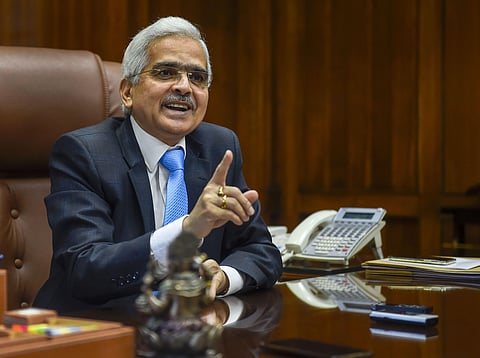

It was a 'talking about talking about' tapering moment for the RBI.
On Friday, the central bank's Monetary Policy Committee (MPC), kept key policy rates and stance unchanged, but decided to roll back last year's emergency measures including scaling back surplus liquidity and winding down G-SAP programme without actually 'rocking the boat.'
Repo rate is held at 4%, while reverse repo rate stands at 3.35%. Real GDP growth estimates were retained at 9.5% for FY22, but inflation estimates were revised downwards to 5.3% this fiscal as against 5.7% projected in August. But as RBI Governor Shaktikanta Das noted, headline inflation continues to be 'significantly influenced' by rising prices of edible oils, petrol and diesel, LPG and medicines.
That said, the key policy takeaway was liquidity normalisation. Now that the pandemic-induced crisis is ebbing, the path towards policy normalisation appears three-pronged: sucking out surplus liquidity, narrowing the rate corridor, which will then set the ground for actual rates liftoff.
For brevity, Das reiterated the approach as one of 'gradualism,' and avoiding suddenness or surprises. Yet, RBI's Friday fix prompted the 10-year benchmark yield to touch 6.30%, while the rupee crossed 75 against the dollar in spot market.
The proposed rollback of exceptional measures instituted during the crisis, will be 'gradual, calibrated and non-disruptive,' and are being done in two levers. First, by aggressively absorbing surplus funds and second by refraining from net liquidity addition by way of G-SAP programme that involves bond purchases.
Surplus liquidity rose further to a daily average of Rs 9.5 lakh crore in October so far and the potential liquidity overhang amounts to over Rs 13 lakh crore. This is something RBI wants to address to preserve financial stability. So, it announced a two-month calendar involving 14-day variable rate reverse repo auctions (28-days if need be) to absorb excess liquidity. These auctions commencing from Friday aren't mandatory for banks and as Das put it, 'V is for voluntary or variable.' Despite the liquidity absorption, RBI vowed to ensure adequate system liquidity to the tune of Rs 2-3 lakh crore by early December under the fixed-rate reverse repo.
This decision wasn't unilateral but was decided after a thorough dialogue with market participants and policy watchers, which appears to be the US Fed equivalence of 'talking about talking about' tapering. And as Das noted, the entire approach will be 'one of gradualism' as 'we are approaching the shores we do not want to rock the boat...as there's a journey beyond the shores.'
The move rebalancing liquidity shouldn't be read as a reversal of RBI's accommodative policy stance as the central bank is decisive about nailing benchmark rates to the floorboard as long as needed to help the $2.9 trillion economy regain its lost momentum.
The second lever includes winding down of the G-SAP programme. Given the liquidity overhang, the absence of a need for additional borrowing for GST compensation and the expected expansion of liquidity in the system, the need for undertaking further G-SAP operations at this juncture does not arise. But Das assured that RBI will 'remain in readiness' to undertake bond-buying, including regular open market operations (OMOs) and operation twist if need beckons. The total liquidity injected during the first six months of FY22 via OMOs is Rs 2.37 lakh crore, as against Rs 3.1 lakh crore injected during the full fiscal FY21.
One of the reasons for ensuring liquidity neutrality is that it's central to monetary policy and financial stability. Markets were also looking for cues as to when RBI may signal raising the reverse repo rate, which will narrow the gap between the repo and reverse repo rate. In the ordinary course, the fixed rate reverse repo is usually set 25 bps below the policy repo rate. By this measure, reverse repo corridor is wider by at least 40 bps given that repo is held at 4%. But as Das quoted Mahatma Gandhi, 'to lose patience is to lose the battle'